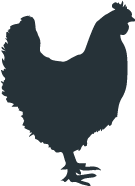Egg binding is a fairly common, potentially life-threatening reproductive emergency affecting hens, who are often referred to as being "egg bound". Egg binding occurs when a hen is straining to produce an egg for more than a few hours.
Egg binding may be brought on by several contributing factors and underlying causes, those of which include:
- Hypocalcemia - Hens with a low blood calcium level.
- Calcium tetany
- Poor quality or unbalanced diet
- Hens laying excessively large eggs
- Starting egg production prematurely
- Increased age
- Trauma
- Obesity
- Mycotoxins in feed
Signs and Symptoms of Egg Binding in Chickens
Clinical signs associated with egg binding will vary depending on the severity and size of the bird. The onset is sudden and the most common clinical signs include:
- Frequent nestbox sitting behavior. Since broody hens exhibit the same behavior, you'll need to know the signs a hen is broody.
- Abdominal straining. The hen may consistently act like they're about to lay an egg. Without an egg appearing.
- Depression. The hen may isolate herself from the other birds, act less engaged and social, close their eyes frequently like their resting, and/or eat less or nothing at all.
- Persistent tail wagging
- Abdominal distension. Look for feces accumulated on the feathers below the vent and compare the size of the hen's abdomen with other chicken.
- Assume a wide stance
- Change in perch location. Hens may sleep in their nestbox or on the ground.
- Dyspnea or increased respiratory rate, resulting from compression of the air sacs with abdominal distension.
- Cyanosis. The comb changes to a crimson color, which will progress to deep purple/blue.
- In cases where the egg is stuck in the pelvic canal, hens may suddenly appear lame on one leg which may progress to full paralysis. This is caused by compression of the ischiatic nerve.
In some cases the egg can be felt inside the caudal abdomen.
How to Help an Egg Bound Hen
Egg binding should be taken seriously and quickly addressed, as the blockage caused by the egg stuck in her reproductive tract can be otherwise fatal. Initially, if caught early enough, there are several supportive care treatments that may help the hen pass the egg. However, if these treatments fail to help the hen pass the egg then immediate emergency veterinary care should be sought.
How Egg Binding is Diagnosed
- Palpation of the Abdomen: In cases where egg binding involves a normal hard shelled egg, the presence of the egg can usually be verified through palpating the hen's abdomen.
- Radiographs: Can be useful in helping to determine the location and number of eggs if they are have a shell present, for it is the calcium from the egg shell which is what makes it detectable through this diagnostic imaging method.
- Ultrasound: This can be useful in cases where hens are trying to pass a soft-shelled, shell-less, or ruptured eggs and where the presence of the egg is not detected through palpation or radiographs.
Treatment for Egg Binding
Treatment for egg binding may consist of medical management, supportive care, environmental modifications, diet evaluation and possible adjustment, and sometimes surgery. Broad-spectrum antibiotics may be needed in cases where an infection is suspected.
